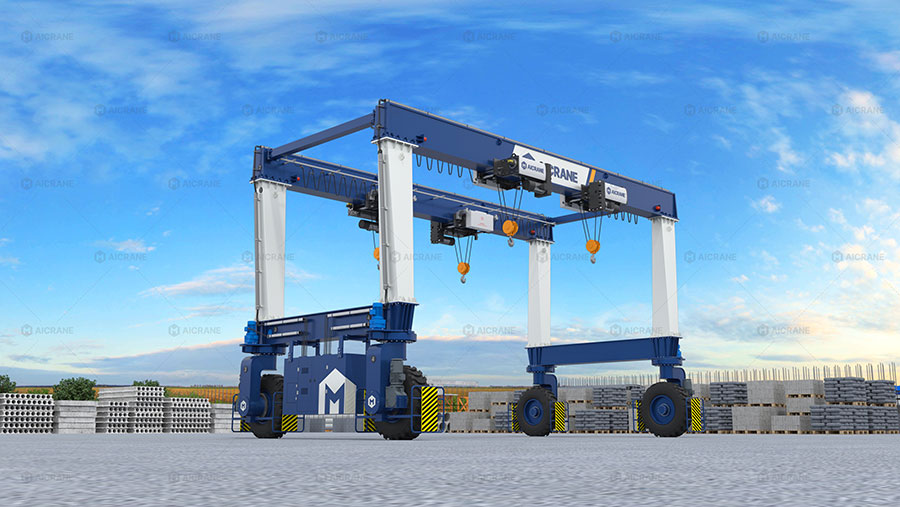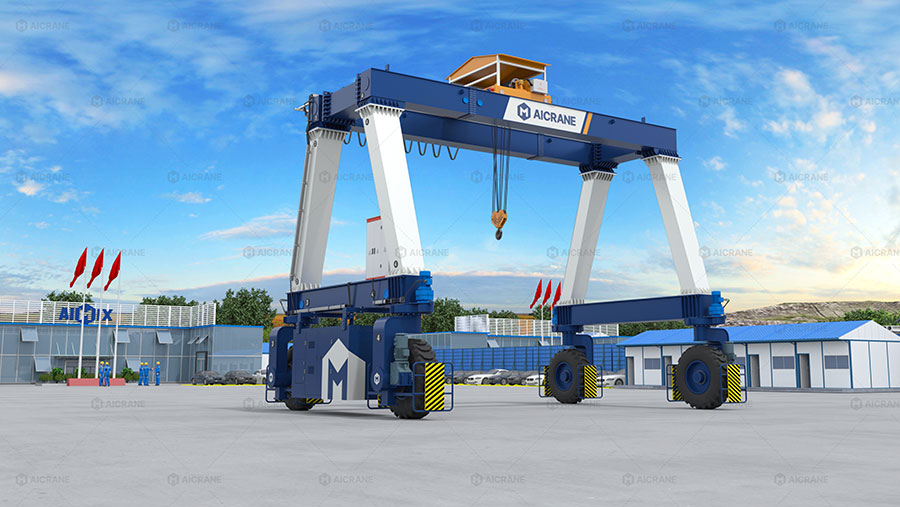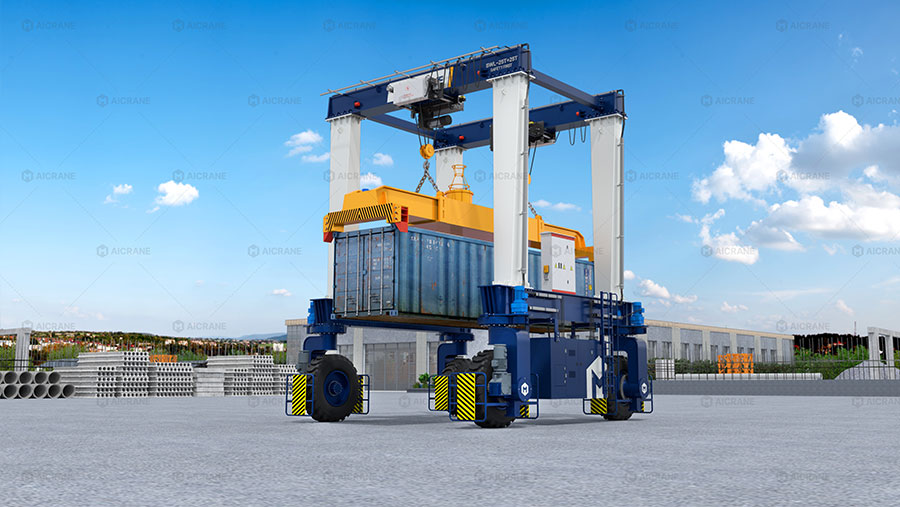Rubber Tyred Gantry (RTG) cranes are integral to modern container terminals, intermodal yards, and industrial facilities where efficient, high-capacity lifting and handling are required. As the size and lifting capacity of RTG cranes increase, structural integrity and weight optimization become critical. One innovative solution gaining attention in recent years is the use of space frame structures in the design of large-capacity RTG cranes.
This article explores the application, advantages, design considerations, and real-world impact of space frame structures in large-capacity rubber tyred gantry, highlighting how this architectural and engineering approach enhances performance, safety, and longevity.

What Is a Space Frame Structure?
A space frame (also known as a space structure or space truss) is a three-dimensional structural framework composed of interconnected struts arranged in a geometric pattern. Unlike traditional planar frames, space frames distribute loads in multiple directions through a combination of tension and compression elements.
Common geometric shapes used in space frames include tetrahedrons, pyramids, and octahedrons. The inherent redundancy and triangulation in space frames result in exceptional stiffness and load-bearing capacity while minimizing material usage.
Why Use Space Frame Structures in RTG Cranes?
Large-capacity RTG cranes must handle heavy loads while remaining mobile and energy-efficient. Using traditional welded box or I-beam structures for the crane gantry or support beams can result in excessive weight and reduced agility. Here’s where space frame structures offer a unique value proposition:
1. High Strength-to-Weight Ratio
Space frames provide a lightweight yet strong alternative to solid steel structures. Their design distributes loads evenly, which reduces local stress concentrations and allows the crane to lift heavier loads without a proportional increase in structure weight.
This is especially important in gantry crane 100 ton and above, where the lifting loads impose significant demands on both vertical and lateral structural performance.
2. Improved Stability Under Dynamic Loads
RTG cranes frequently operate under dynamic conditions—swaying loads, trolley acceleration, and cross-travel movements. The triangulated geometry of space frames offers excellent resistance to torsional and lateral deflection, which is crucial in maintaining stability during operation.
3. Reduced Material and Fabrication Costs
Despite the complex appearance, space frames can be more cost-effective to fabricate and assemble than thick-section box girders. Standard tubular or pipe members are typically used, and modular assembly simplifies construction and logistics.
For manufacturers and terminal operators, this translates to lower production costs and faster delivery times for large RTG crane projects.
4. Modular and Scalable Design
Space frame modules are highly modular and adaptable. This is useful in RTG cranes where designs often need to be customized for different container stacking heights, spans, and lifting configurations.
The modularity also facilitates transportation, on-site assembly, and future expansion or modification of the crane structure.

Structural Components of RTG Cranes with Space Frames
In RTG cranes, space frame designs are typically integrated into the gantry legs, crossbeams, and upper portal sections. Here’s how space frame elements are applied:
1. Portal Legs
The vertical portal legs of large RTG cranes are subject to bending and compressive loads during lifting and travel. Space frame legs constructed using diagonal tubular members provide:
-
Greater load-carrying efficiency.
-
Reduced material thickness.
-
Easier inspection access.
2. Top Beams and Gantry Girders
Space frame design in the horizontal gantry allows for longer spans with minimal deflection. These beams support the trolley system and are critical for load transfer.
Instead of using a single monolithic girder, a triangulated space truss reduces dead weight while maintaining stiffness—especially important for wide-span RTG container cranes handling 6 to 9 rows of containers.

3. Cantilevers and Support Extensions
In some cases, RTG cranes include cantilevered sections for maintenance access or equipment housings. Space frame construction in these regions helps reduce the overhanging weight and minimizes moments acting on the main structure.
Design Considerations for Space Frame RTG Cranes
Implementing a space frame structure in RTG cranes involves multiple technical considerations:
1. Load Path Optimization
Each member in a space frame must be strategically placed to manage compressive and tensile forces. Computer-aided design and finite element analysis (FEA) tools are essential for optimizing load paths and ensuring structural efficiency.
2. Joint and Node Design
Connections between members—often at nodal joints—must be robust, fatigue-resistant, and easy to fabricate. Bolted or welded spherical nodes are commonly used in modern space frame RTG designs.
3. Corrosion Resistance
RTG cranes typically operate in coastal or marine environments. The open design of space frames enables better airflow and drainage but also exposes more surface area to corrosion. Protective coatings, hot-dip galvanization, or weather-resistant paints are essential.
4. Maintenance Accessibility
While space frames are easier to inspect visually, maintaining structural elements in high or congested areas can be a challenge. Design provisions for maintenance walkways, platforms, and access points should be integrated.
Real-World Examples and Applications
Several major gantry crane manufacturers and port operators have adopted space frame designs in large-capacity RTG cranes:
-
Shanghai Zhenhua Heavy Industries (ZPMC) has implemented space frame top beams in RTGs used in mega ports across Asia and the Middle East.
-
Kalmar and Konecranes use optimized truss-like leg designs in their higher-capacity RTG series to improve mobility without sacrificing strength.
-
In Africa and South America, space frame RTGs have been deployed for container handling in regions where logistics and transport restrictions favor modular, lightweight equipment.
These applications demonstrate that space frame structures are not just a theoretical improvement—they offer tangible benefits in performance, durability, and operational economy.
Advantages vs Traditional Designs
| Feature | Traditional Welded Frame | Space Frame Structure |
|---|---|---|
| Weight | Heavier | Lighter |
| Load Distribution | Linear | Multi-directional |
| Torsional Rigidity | Lower | Higher |
| Fabrication | Complex for large sections | Modular and standardized |
| Maintenance | More confined | Easier access |
| Cost (for large cranes) | Higher | Lower overall |
Future Trends and Innovations
As crane manufacturers aim for greater sustainability, lower operational costs, and increased container yard throughput, the demand for lightweight, high-strength structures will rise.
Future innovations may include:
-
Hybrid space frame designs using aluminum or composite materials.
-
3D-printed node components for ultra-precise, lightweight joints.
-
Integration with smart sensors for real-time structural health monitoring.
-
Development of collapsible or transportable space frame kits for fast-deployment RTGs in temporary or developing terminals.
Conclusion
The adoption of space frame structures in large-capacity RTG cranes marks a significant step forward in crane design and engineering. With advantages in weight reduction, load distribution, cost-efficiency, and structural performance, space frames enable RTG cranes to perform better, last longer, and adapt to evolving port needs.
As ports continue to demand greater throughput and flexibility, the space frame structure is poised to become a mainstream design solution, empowering the next generation of container handling systems to be stronger, smarter, and more efficient than ever before.